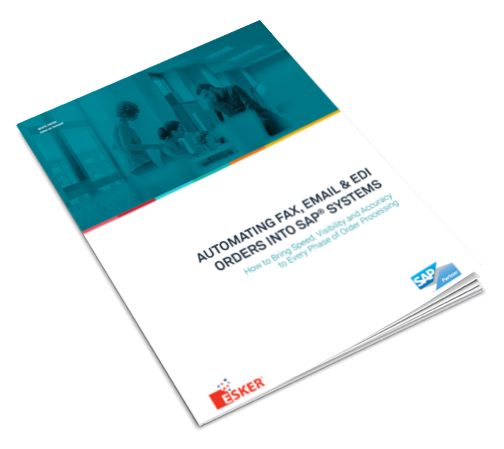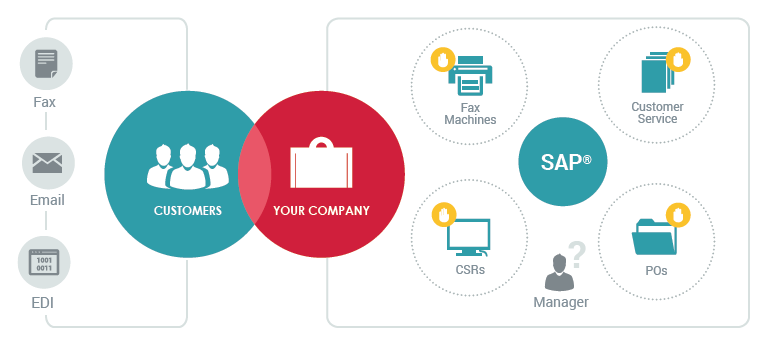
How to Bring Speed, Visibility and Accuracy to Every Phase of Order Processing
 In a perfect world, every
In a perfect world, every
The reality, unfortunately, is not so rosy. Orders come in via a variety of formats — the most predominant being fax and email. The problem is, fax and email orders require vast amounts of time and labor to process, resulting in high error rates and slower fulfillment. Plus, when Customer Service folks have to print out and manually enter orders into SAP, they’re prevented from doing what they do best: serving customers. Ultimately, fax and email orders lengthen the order-to-cash cycle and cause your company’s competitiveness and customer service to suffer.
Regardless of how large or small an organization is, fax and email orders typically mean:
- High order processing cost
- Complex IT environment
- Difficulty prioritizing orders
- Poor responsiveness to customers
- Lack of visibility and process control
- Lengthened order-to-cash cycle
For companies looking to overcome these challenges and gain the efficiencies of automated, electronic processing of fax and email customer orders into their SAP systems, this white paper outlines essential factors to consider.
Why Change Hasn’t Come Easy
One oft-considered option for avoiding the headaches of fax and email order processing is to push customers toward EDI. However, there are still many customers who are simply unwilling or unable to do so. While larger corporations may have the leverage to force EDI adoption, most companies accept fax and email orders as a necessary evil rather than refuse business or agitate customers.
Another roadblock to implementing change is the cost of EDI systems, which many businesses cannot afford. Despite the standardized nature of EDI, everyone still seems to want their own formats. For example, companies routinely modify the EDI 850 purchase order format to fit their particular needs. Even in the best situations, large organizations often have 20 to 30 percent of their orders coming in by fax or email.
About This White Paper
If your company wants to eliminate the problems caused by fax and email orders, there are many factors to consider. This white paper explores those
Fax & Email Orders: Where It All Goes Wrong
Sales orders typically come to companies in three different ways — fax,
How Orders Arrive
 Fax
Fax
Fax often represents the bulk of a company’s order management expenses regardless if the number is a minority or majority of total sales order volume. Fax orders typically require a separate processing environment made up of fax machines or fax server software to capture orders and distribute them among Customer Service Representatives (CSRs) who enter the information into SAP.
 Email
Email
In the interest of going paperless, some companies have started sending purchase orders to suppliers by email. This eliminates paper on the customer side, but on the supplier side, CSRs are forced to print the email, walk back to their desks and key it in just as they might do with a fax order.
 EDI
EDI
In addition to faxing systems, many companies have an EDI system. The question is, how many EDI orders are actually processed without being touched? In Esker’s experience, it’s not uncommon for the number to be as low as 65 percent. Orders might be coming in the proper format, but item details could be wrong in the EDI file (e.g., product number, pricing, etc.). If this is the case, the order goes through a complex workflow before it is entered into SAP.

Pitfalls of Outsourcing the Problem
In Esker’s experience, many companies have used outsourcing to automate aspects of order processing. However, because of exceptions that are too complex for the outsourcing firm to handle, some orders still need to come back into their workflow. This also can happen with add-ons offered by EDI vendors to translate faxes into EDI. These approaches may pass off the problem (or part of it) to someone else, but they do not fully automate the process.
Other Functional Considerations
Consider these questions: Do you want to separate single fax or emails that contain multiple orders to ensure they’re handled independently rather than as one large order?; Do you want the ability to process orders in
Turning to Automation For Help
To continue reading this white paper, please fill out the form below!

|
|
